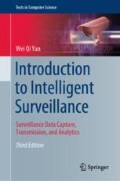Abstract
In surveillance, we need present a story of a moving object. This story is called event which is the best way to describe the motion of this object. In this chapter, we will critically compare and evaluate the major components of a surveillance event, understand the event as a basic semantic unit of intelligent surveillance. We will introduce the algorithms how to detect and recognize an event.
Access this chapter
Tax calculation will be finalised at checkout
Purchases are for personal use only
References
Adams A, Ferryman M (2012) The future of video analytics for surveillance and its ethical implications. Secur J 28(3):272–289
Alpaydin E (2010) Introduction to machine learning, 2nd edn. The MIT Press, Boston
Argano M, Gidwani T, Yan W, Issa F (2012) A comprehensive survey of event analytics. Int J Digit Crime Forensics 4(3):33–46
Calvel C, Ehrette T, Richard G (2005) Event detection for audio-based surveillance system. In: IEEE ICME, pp 1306–1309
Chen D, Tao Z, Ma G (2008) Application of wireless sensor networks for monitoring emergency events. In: IEEE conference on sensors, pp 518–521
Gong S, Xiang T (2003) Recognition of group activities using dynamic probabilistic networks. In: IEEE ICCV, pp 742–750
Haritaoglu I, Harwood D, Davis LS (2000) \(W^4\): real-time surveillance of people and their activities. IEEE TPAMI 22(8):809–830
Huang M, Liu Z (2012) Layered event ontology model. In: International conference on fuzzy systems and knowledge discovery, pp 948–951
Iosifidis A, Tefas A (2012) View-invariant action recognition based on artificial neural networks. IEEE Trans Neural Netw Learn Syst 23(3):412–424
Ivanov Y, Bobick A (2000) Recognition of visual activities and interaction by stochastic parsing. IEEE PAMI 22(8):852–872
Ke Y, Sukthankar R, Hebert M (2005) Efficient visual event detection using volumetric features. In: IEEE ICCV, pp 166–173
Maryam K, Reza K (2012) An analytical framework for event mining in video data. Artif Intell Rev 41(3):401–413
Naphade M, Huang T (2002) Discovering recurrent events in video using unsupervised methods. In: International conference on image processing, vol 2, p 13
Niebles J, Wang H, Li F (2008) Unsupervised learning of human action categories using spatial-temporal words. Int J Comput Vis 79(3):299–318
Oh S, Hoogs A, perera A, Cuntoor N, Chen C, Lee JT et al (2011) A large-scale benchmark dataset for event recognition in surveillance video. In: IEEE conference on computer vision and pattern recognition, pp 3153–3160
Popoola O, Wang K (2012) Video-based abnormal human behavior recognition: a review. IEEE Trans Syst Man Cybern Part C Appl Rev 42(6):865–878
Rui Y, Anandan P (2000) Segmenting visual actions based on spatio-temporal motion patterns. In: IEEE Conference on computer vision and pattern recognition, pp 111–118
SanMiguel JC, Martinez JM, Garcia A (2009) An ontology for event detection and its application in surveillance video. In: IEEE AVSS, pp 220–225
Sigal L, Balan A, Black M (2010) Synchronized video and motion capture dataset and baseline algorithm for evaluation of articulated human motion. IJCV 87(1–2):4–27
Stauffer C, Eric W, Grimson L (2000) Learning patterns of activity using real-time tracking. IEEE PAMI 22(8):747–757
Tran S, Davis L (2008) Event modeling and recognition using markov logic networks. In: ECCV, pp 610–623
Tziakos I, Cavallaro A, Xu L (2010) Event monitoring via local motion abnormality detection in non-linear subspace. Neurocomputing 73(10):1881–1891
Velipasalar S, Brown L, Hampapur A (2006) Specifying, interpreting and detecting high-level, spatio-temporal composite events in single and multi-camera systems. In: IEEE computer society conference on computer vision and pattern recognition workshop, p 110
Westermann U, Jain R (2007) Toward a common event model for multimedia applications. IEEE MultiMed 14(1):19–29
Wu Z, Lin D, Tang X (2006) Deep Markov random field for image modelling. In ECCV 2016, pp 295–312
Xie L, Sundaram H, Campbell M (2008) Event mining in multimedia streams. Proc IEEE 96(4):623–647
Yan W, Kieran D, Rafatirad S, Jain R (2011) A comprehensive study of visual event computing. Springer Multimed Tools Appl 55(3):443–481
Zelnik-Manor L, Irani M (2001) Event-based analysis of video. In: IEEE CVPR, vol 2, pp 123–130
Author information
Authors and Affiliations
Corresponding author
Rights and permissions
Copyright information
© 2019 Springer Nature Switzerland AG
About this chapter
Cite this chapter
Yan, W.Q. (2019). Visual Event Computing I. In: Introduction to Intelligent Surveillance. Texts in Computer Science. Springer, Cham. https://doi.org/10.1007/978-3-030-10713-0_6
Download citation
DOI: https://doi.org/10.1007/978-3-030-10713-0_6
Published:
Publisher Name: Springer, Cham
Print ISBN: 978-3-030-10712-3
Online ISBN: 978-3-030-10713-0
eBook Packages: Computer ScienceComputer Science (R0)

